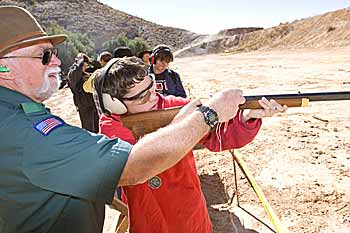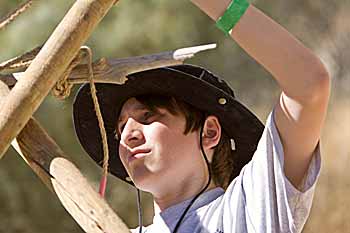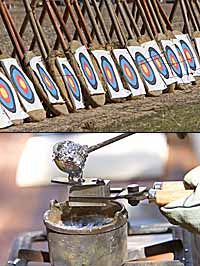Rendezvous of the Mountain Men
By Nettie Hunsaker Francis
Photographs by John R. Fulton Jr.
At the Las Vegas Area Council's annual encampment, Scouts experience the colorful culture of an old-time gathering of Rocky Mountain fur trappers.
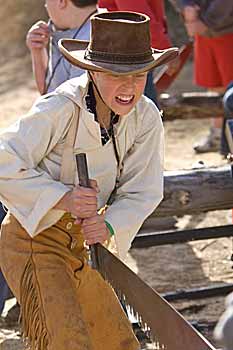 Dressed in mountain man garb, Scout Taysen Barben, Troop 1891, Cedar City, Utah, goes all-out in the log saw challenge. |
As the sun set in the southern Nevada sky, long shadows crawled across the desert floor, wind blew through the tamarisk trees, and a coyote howled in the distance.
In a circle of white canvas tepees pitched in a small valley, a man dressed in buckskin stirred a large pot of stew while hungry boys seated on wooden chairs waited nearby. Some boys were dressed in Scout uniforms, while others wore frontier-style leather vests and coonskin caps.
A short distance down a dirt road, dozens of other Scouts were setting up tents in a field.
The 23rd annual Las Vegas Area Council's Mountain Man Rendezvous—held in March 2006 at the Moapa River Indian Reservation near Glendale, Nev., an hour north of Las Vegas—was under way.
 In the "primitive camping area," Rendezvous enthusiasts Michael Voegele (top) and DelRay Olsen (bottom) display different types of frontier clothing, while Julien Flesher, Las Vegas Troop 430, tries gold panning. |
The purpose of the rendezvous is to teach youth about the tradition of the annual mountain man summer gatherings held from approximately 1825 to 1840 in various locations in the western United States.
"We want youth to appreciate what went into settling our country, including what mountain men did," said Doug Yardley, an event staff member.
A 19th-century rendezvous brought Rocky Mountain fur trappers, known as mountain men, and Native Americans together with representatives of supply companies from St. Louis and other points east. In addition to serving as an occasion for trappers to exchange their pelts for much-needed supplies for the coming year, rendezvous was a time of festivities and friendly competition.
This modern Scout version of a rendezvous also brings together many people, as troops, teams, and crews come from Utah and Arizona, as well as Nevada.
Units arrived on Friday evening. Some pitched modern tents in the main camping area while others, using tepees or white canvas tents, opted for a special "primitive camping area." In this site, campers wore mountain man clothing and prepared food with Dutch ovens and other frontier camping tools.
As the sky darkened, youth and leaders gathered for an opening campfire. They soon became familiar with such mountain man terms as booshway, the leader or organizer of the rendezvous, and segundo, the second in command. They also heard tall tales from rendezvous staff members dressed in the same type of clothing worn by frontier fur trappers.
The next morning Scouts rotated as units through more than 20 events, many of them similar to activities at a typical rendezvous of 1825 to 1840.
"The rendezvous has a special appeal to Scout-age youth because the activities include games of skill," commented Gary Lewis, council activities director.
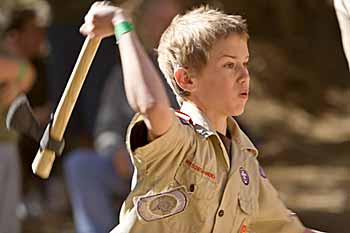 Ryan Holmstrom, Troop 95, Henderson, Nev., launches a tomahawk at a target. |
Another reason for the event's popularity is that many skills learned by mountain men and in Scouting focus on being at home in the outdoors. And many rendezvous activities, such as woodcarving and fire building, use basic skills Scouts may have already learned on other, more traditional, camp-outs.
"The mountain man feeling is an extension of real outdoor Scouting," summed up Chuck Ankenman, committee chairman for Las Vegas Troop 64.
Every youth participant received a medallion to wear throughout the weekend and earned a bead for participating in each activity. Scattered throughout a small canyon on the reservation, the events varied from archery to "beaver sticking," a type of spear-throwing contest.
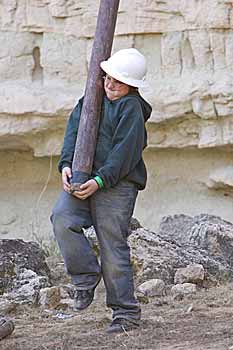 Garrett Winters, Troop 390, tests his ability at the difficult task of tossing a caber, or log. |
As boys waited their turn to throw the long spears into a log, a rendezvous staff member explained that "mountain men used the beaver stick for hunting because it didn't use up precious ammunition."
At other events, Scouts made rope, panned for gold, and carved arrowheads ("flint knapping").
Nearly every activity included a competitive element for either individuals or units. For example, each Scout's performance was judged separately in events like horseshoes and the caber (log) toss, while units competed as teams to see how many animal tracks they could identify or how quickly they could lash together a tower.
Eagle Scout Isaiah Haywood of Las Vegas Troop 256 said he has attended the rendezvous for four years and especially enjoys the competitions.
This year Isaiah took first place in trapping, setting seven double-spring traps faster than anyone else (animals were not actually trapped), while Troop 256 placed first in pioneering, lashing together a tower in less than 30 minutes.
"I enjoy the rendezvous because we get to do all kinds of stuff we don't normally do, like throwing knives and tomahawks," Isaiah said.
 Rendezvous newcomer Kayla Salemme, Venturing Crew 95, gets her first try at frontier activities. |
Venturer Kayla Salemme, 15, from Henderson, Nev., Crew 95, had her first experience throwing knives and tomahawks.
"The rendezvous has given me a new appreciation for what mountain men had to do to survive," she said.
A mountain-man model camp let visitors see life as lived in the 1830's. On display were white canvas tents and tools that trappers used, such as flintlock rifles, cooking utensils, and silverware dating to the 1800's. Campers examined strings of authentic glass trade beads, which trappers used to trade for supplies.
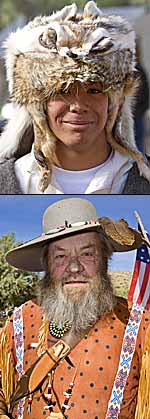 Cliff Robbins, Venturing Crew 62, sports a rustic hat made from coyote fur, while history buff Wayne Burgess displays his colorful mountain man outfit. |
Most of the items belong to Booshway Jim Humphrey, who also does mountain man re-enactments and displays for other Nevada historical events.
Scouts and Venturers love the rendezvous, Humphrey said. "It gives them a perception of history that they are unable to learn at any other venue. We are hoping to keep the pioneer spirit alive."
Throughout the day the sound of gunfire echoed through the small canyon. Black-powder-rifle shooting was one of the most popular events. As boys exited the event, they talked excitedly about the experience.
"I hit the target twice," Scout Josh Jarvis from Las Vegas Troop 256 reported.
"The rendezvous is so successful because everything is hands-on," observed Steve Fisher, a Scouter from Las Vegas Troop 270. "Scouts don't just shoot black-powder rifles, they also have the chance to cast lead bullets."
Scoutmaster Scott Smith of Las Vegas Troop 64 agreed. "The rendezvous exposes boys to a lot of new experiences, things they can't (or shouldn't) do at home, like the atlatl throw."
The atlatl is a hunting device prehistoric peoples used before there were bows and arrows. It features a wooden handle used to propel a short spear (called a dart) at an accelerated speed. Scouts used the wooden handle to launch the darts toward a target.
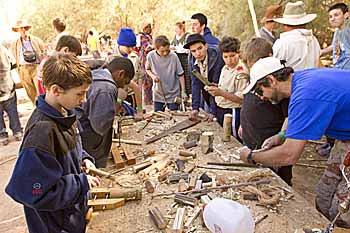 Hands-on educational activities, like this workshop at which Scouts crafted wooden mallets, generated plenty of enthusiasm from many Rendezvous participants. |
By late afternoon, the events had closed. Everyone gathered back at the campfire bowl for an awards ceremony.
In a celebration of the competitive spirit of the original rendezvous, the top three finishers in each event were recognized. They received contemporary camping equipment, such as sleeping bags and daypacks, for prizes.
As units checked out to go home, participants filled out a questionnaire, noting what they enjoyed and which elements could be improved.
Staff leaders met later to review the questionnaires and discuss possible changes for next year. They found that the response was overwhelmingly positive, with youth and leaders planning to return in 2007.
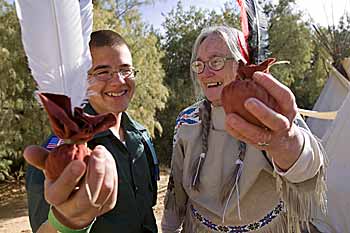 Doris Kempf, committee member with Las Vegas Troop 208, shows Venturer Stone Holden, of Crew 130, the first steps in playing a Native American game whose concept is similar to that of volleyball. |
The reaction of Cody Weiss, 13, of Las Vegas Troop 276, to his first rendezvous experience was typical: "I would love to come back next year. I think I could have been a mountain man."
Troop 64 Scoutmaster Scott Smith saw additional benefits from the rendezvous: "This type of activity helps commit boys to Scouting. Once you get people coming, they keep coming."
The responses show how the spirit of the rendezvous is contagious for both youth and adults, observed 2006 rendezvous chairman George Crossman. In addition to games and activities, he said, "it's the camaraderie of the rendezvous that brings back people and friends each year."
Freelance writer and Scouter Nettie Hunsaker Francis lives in Las Vegas, Nev. Her most recent article for Scouting, describing the Trapper Trails Council's multicourse Family Training Camp, is available at www.scoutingmagazine.org/issues/0601/a-time.html.
Great Experiences, Quality Volunteers
The camporee began in 1984 as the "Varsity Mountain Man Rendezvous," a high adventure activity for Varsity Scout teams in the BSA program for boys 14 to 17. "The idea to hold a mountain man rendezvous appealed to everyone, youth and leaders," remembers Earl Lord, council volunteer, of the 1984 rendezvous. "It was something brand new." Thirty Scouts attended the first rendezvous; they canoed from the bottom of Hoover Dam to Griffith Canoe Base on the Colorado River, where they participated in mountain man activities. "Word of the rendezvous spread, and our numbers just exploded," says Lord. Today, the event is open to Boy Scouts 13 and older, as well as Varsity Scouts and Venturers. Nearly 1,000 participants, plus 700 adult leaders and staff, attended the 2006 event. Key to the success of the rendezvous is its special appeal to youth. Camping in tepees, dressing up in buckskin, and learning mountain man skills make the weekend much more than a typical council camporee. "Our goal is to provide a wholesome activity that is so varied kids can't find anything like it anywhere else," Lord explains. "We want them to look forward to next year and come again. Some return with their own buckskins and make their own costumes." Jordan Hatch, 14, from Troop 652 of Enoch, Utah, attended his first rendezvous in 2006, dressed in a shirt and capote (a long, hooded cloak) borrowed from his uncle and leggings he made himself. He looked forward to the weekend, he said, because "I learned about the mountain men in school." In addition to appealing to youth, the rendezvous has an attraction for volunteers, says council staff adviser Jim Schmidt. The adults enjoy the historical aspects and high adventure activities as much as the youth, and a core group of people has been involved for many years, Schmidt says. "It's those quality volunteers who keep the rendezvous going each year." Jim Humphrey, 2006 rendezvous booshway (leader) and self-professed history buff, became interested in the mountain man era in 1971 and attended his first Mountain Man Rendezvous in 1994. The experience for adults goes beyond being an outlet for their interest in history, he points out. "It's the chance to effect a change in a youth's life that brings us back each year." In 23 years, the rendezvous has been held at four locations, including its current site on the Moapa River Indian Reservation. —N.H.F. |
A Powerful Partnership
"In the days of the original rendezvous, there had to be a partnership between the mountain men and the Indians to make the event successful," comments Jim Humphrey, 2006 Las Vegas Area Council Mountain Man Rendezvous booshway (leader). That partnership exists today between the Las Vegas Area Council and the American Indians of the region. For the past four years, the Moapa Band of Paiutes on the Moapa River Indian Reservation has allowed the Scouts to use part of their land for the annual council rendezvous. In exchange, Scouts and leaders give their time and service to beautify the area. Before the rendezvous, two or three cleanup weekends are held on the reservation, and troops and crews are invited to camp overnight at the rendezvous site. They spend the weekend picking up trash, moving rocks and dirt away from the individual event sites, and clearing tamarisk trees, which grow plentifully there. The rendezvous isn't the only time that Scouts volunteer on the reservation. Many Eagle Scout service projects have also taken place there. "We appreciate the Boy Scouts because they are respectful to our land and our culture," comments Kami Sue Miller, vice chairman of the Moapa Tribal Council. "We welcome our relationship with them and hope it continues." —N.H.F. |
Safety First
Activities such as black-powder-rifle shooting and tomahawk- and knife-throwing offer a unique element of excitement to the Las Vegas Area Council rendezvous. But, they also make safety a top priority. "An event like this has a lot of safety aspects," comments Gary Lewis, council activities director. "We follow all BSA standards outlined in the Guide to Safe Scouting (available online at www.scouting.org/pubs/gss). And in some areas, the council has set extra guidelines. For example, on Trader's Row, where artisans come to sell or trade goods, pocketknives are a big attraction. A youth must present a permission slip signed by a parent and a Scout leader to purchase a knife. Scouts must also have a Totin' Chip card to carry a pocketknife at the rendezvous. They can earn the card at one of the rendezvous event stations. Members of Venturing Crew 1069, chartered to the nearby Nellis Air Force Base Civil Air Patrol, provide security during the weekend. They help direct parking, keep watch during the night, and ensure that participants adhere to rendezvous camper guidelines. —N.H.F. |
On the WebTo read about other activities that can give Scouts a hands-on learning experience about our nation's past, go to our search page and click "American History." |
October 2006 Table of Contents
Copyright © 2006 by the Boy Scouts of America. All rights thereunder reserved; anything appearing in Scouting magazine or on its Web site may not be reprinted either wholly or in part without written permission. Because of freedom given authors, opinions may not reflect official concurrence.
